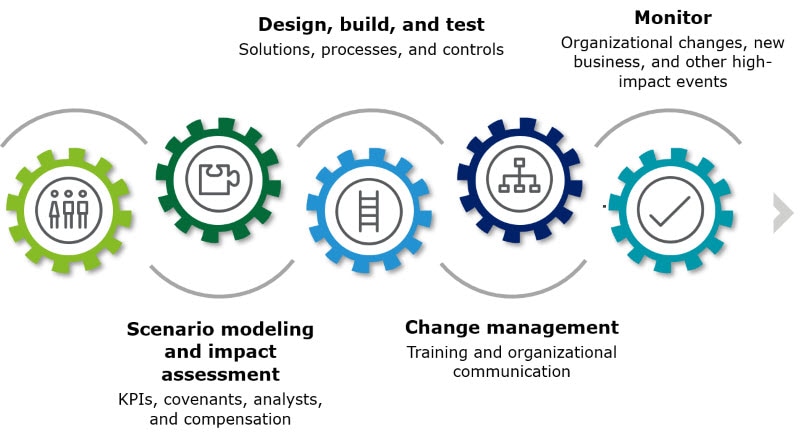Building a sustainable accounting framework in a dynamic regulatory environment has been saved

Perspectives
Building a sustainable accounting framework in a dynamic regulatory environment
Leveraging resources and implementing a new framework that enhances transformation
With the launch of many new accounting standards in recent years, organizations are finding the need to build a sustainable framework to implement these new requirements. Now, with regulatory changes and new standards coinciding with economic cycle changes due to the effects of the global pandemic, how do finance professionals create a process that can evolve with the accelerated changes in the dynamic regulatory environment?
August 12, 2020
A blog post by Beth Kaplan, managing director, Deloitte & Touche LLP
A scalable and flexible framework can be key to supporting a more efficient and effective accounting process. However, for it to do so, it is important to understand a broad spectrum of implementation requirements for new accounting standards and the business and technology implications of accounting changes. Once the new standards are understood, finding the potential value in accounting and regulatory changes and taking lessons learned from past implementations can help organizations define their vision, leverage existing resources, and develop a new framework that optimizes their organization’s accounting model for controllership.
Considerations for creating a new accounting framework
- Set the stage by understanding new regulatory and accounting changes and their potential value to the organization
- Identify lessons learned from past implementations to leverage resources and optimize transformation
- Map out an implementation life cycle and create a framework for the new accounting model
Setting the stage for transformation by understanding the impacts and value of regulatory changes
Transforming the approach to operationalizing accounting change typically begins with gaining a broad understanding of recent regulatory requirements already implemented by many entities and emerging changes many will be implementing in the near future.
- New standards implemented: Revenue recognition, leases, derivatives and hedging, cloud computing, and current expected credit losses (CECL)
- Standards implemented by 2021: Leases, derivatives and hedging, and cloud computing in the private sector
- Standards for 2022 and beyond: CECL (1/2023) in the private sector and long-duration targeted improvements (LDTI) (1/2024) in both public and private sectors
Once the regulatory requirements and impending changes are identified and understood, organizations can begin developing a new accounting framework by first understanding the impacts of these changes and finding the potential value each regulatory change may offer controllership and the broader organization. Some potential impacts and value-adds by topic may include:
- Lease accounting: Increased collaboration between accounting and the business; new lease technology solutions; all leases on one balance sheet
- Revenue recognition: Single model for recognition; potential opportunities for tax savings
- Cloud computing: Opportunity to leverage technology and automation for efficiencies
- Derivatives and hedging: Opportunity to proactively manage key metrics, loosening of hedging requirements, and expanded hedging opportunities
- CECL: Cost-efficient compliance; forward-looking loss insights
- Insurance: Leveraging data to enhance business decisions (for example, lease vs. buy); new profit patterns
Finding the lessons learned from past accounting change implementations
Implementations generally affect the entire organization
Both at a higher organizational level and a tactical level, many new implementations affect the entire organization. Because of this, it is important to get stakeholder buy-in across the organization.
It is important to bring together the right people at the right level to implement changes
When you are bringing different parts of an organization together to work for a common goal, there can sometimes be challenges because these different parts of the organization may not work together all the time. Some time is typically needed to form working relationships and begin working together collaboratively. Executive buy-ins can help.
Effective implementations manage data and new or modified technology across standards
Across many implementations, when an organization has to use technology to help with the implementation of new standards, successful companies have effectively managed the data and utilized the implementation or modification of such technology across other standards. For example, if a company has to make changes to technology for revenue recognition, that infrastructure may be able to cut across to other standards such as lease accounting and cloud computing. A well-planned framework can help maximize the use of new or modified technologies.
Map out an implementation life cycle and create a framework for the new accounting model
A scalable and flexible framework can support an efficient and effective accounting process. By taking lessons learned from past implementations and potential value from drivers of change, organizations can leverage existing resources and develop a new framework that optimizes the accounting model for controllership.
This new framework may be more effective if it is structured to benefit the broader organization—including data management, technology, process enhancement, talent, and analytics—and if it is implemented with a methodology that includes phases such as the following: monitor, implement, maintain, and improve for change management.
Illustrative phases for creating a new framework
Monitor drivers of change
Implement a new framework
Maintain with governance
Improve to accommodate changes
Mapping out a life cycle for the implementation phase can allow an organization to better leverage existing resources and can enable the value of assessments and lessons learned to support the implementation methodology by giving structure to the process with an illustrative implementation life cycle, such as the following:
Implementation life cycle for a new framework

Step 1: Assessment and visioning: Accounting, tax, and operational benefits; value drivers; and roadmap
Step 2: Scenario modeling and impact assessment: KPIs, covenants, analysts, and compensation
Step 3: Design, build, and test: Solutions, processes, and controls
Step 4: Change management: Training and organizational communication
Step 5: Monitor: Organizational changes, new business, and other high-impact events
Getting started on a new framework
Maintaining the framework with governance and optimizing the framework to allow for change management are the final two phases in the process. Some considerations for these two phases, the implementation life cycle, and the framework process include the following:
- Have a playbook: Develop a detailed playbook and roadmap to establish the organization’s timeline and path forward
- Governance: Determine the governance structure, organizational charters, project management, and steering committee. Governance also includes the roadmap and playbook, change management, central communications, and policies for the framework
- Team development: Develop cross-functional teams that include all relevant stakeholders, such as finance, accounting, tax, and IT
- Communicate: Development of communication structure, including change management and organizational training requirements
To take a deeper dive into the methodology and process of creating a new accounting framework, including how some organizations are developing effective frameworks that leverage technology and better allow for change management, listen to our Dbriefs series: The evolution of accounting: Building a sustainable framework for the future.
Visit the Controllership Insights blog for additional blog posts.
This publication contains general information only and Deloitte is not, by means of this publication, rendering accounting, business, financial, investment, legal, tax, or other professional advice or services. This publication is not a substitute for such professional advice or services, nor should it be used as a basis for any decision or action that may affect your business. Before making any decision or taking any action that may affect your business, you should consult a qualified professional advisor. Deloitte shall not be responsible for any loss sustained by any person who relies on this publication.
Recommendations
Controllership Insights
Center for Controllership™
Controllership's response to crisis: COVID-19 and beyond
A catalyst for stability in an unstable environment




